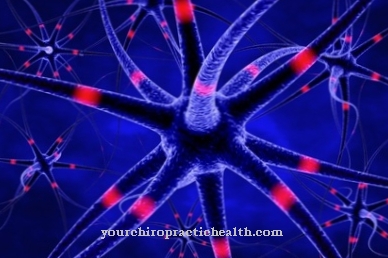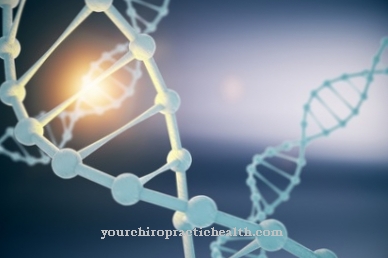The endocrine secretion refers to the release of hormones or mediators (messenger substances) into the blood. The endocrine glands are responsible for secretion. The released active ingredients are effective even in the smallest concentrations.
What is the endocrine secretion?

Endocrine secretion is the secretion of hormone-like active substances or mediators through endocrine glands into the blood or the lymph. Even very low concentrations of active substances have great effects in the organism.
The terms "endocrine gland" or "endocrine gland" are used synonymously. The endocrine glands include specialized hormonal glands, tissue with hormone-producing cells, specialized neurons and other organs that are involved in the hormonal control function.
Specialized endocrine glands secrete one or more hormones. There are, in turn, hormones that act directly on the target organ or that control and regulate the formation of other hormones within the framework of a regulatory mechanism. In this way, control loops form in the organism that guarantee hormonal balance.
Specialized hormone glands include the pituitary, pineal, thyroid, parathyroid, adrenal and islet cells of the pancreas. Tissues with hormone-producing cells can be found, for example, in the skin, heart, liver, gastrointestinal tract and in the gonads (testes and ovaries).
The hormones secreted by these tissues are tissue hormones that often act locally. The neurohormones released by the neurons are responsible for connecting the nervous system with the hormonal system. The central neuroendocrine organ is the hypothalamus, which belongs to the brain and, as the most important control center, controls the autonomic nervous system and at the same time regulates the hormonal system via important neurohormones.
Function & task
With the help of hormones and mediators, endocrine secretion controls all bodily processes as a whole. It is subject to a control circuit that ensures hormonal balance. Many hormones have their counterparts. For example, the hormone insulin lowers blood sugar levels. The glycogen, which is also formed in the pancreas, acts as an antagonist. Glucagon releases glucose by breaking down the glucagon stored in the liver in order to keep the blood sugar level constant.
The central endocrine organ is the pituitary gland. Several hormones with different functions are produced in the pituitary gland. The pituitary gland secretes, among other things, hormones that act directly on organs, gonadotropic hormones and non-gonadotropic hormones. Growth hormone and prolactin are among the directly acting hormones of the pituitary gland.
The follicle-stimulating hormone (FSH) and luteinizing hormone (LH) function as gonadotropic hormones. Both hormones regulate ovulation in women and sperm maturation in men.
Other pituitary hormones stimulate the adrenal and thyroid glands to produce hormones. The adrenal glands produce the glucocorticoid hormones cortisol, aldosterone and small amounts of sex hormones. While cortisol is responsible for the catabolic metabolism, aldosterone regulates the mineral balance. The thyroid in turn produces the thyroid hormones thyroxine and triiodothyronine.
The hypothalamus functions as the central organ of the neuroendocrine regulatory mechanism. In addition to controlling the autonomic nervous system, the hypothalamus secretes various releasing and inhibiting hormones, which regulate the formation of other hormones.
In addition to the large hormonal control loops, there are other smaller control loops through which the formation and inhibition of tissue hormones is regulated. At the same time, however, all control loops are linked to one another. Overall, the hormonal processes are subject to very complex regulatory mechanisms, which are not yet known in detail. New hormones are still being discovered regularly.
In addition, more and more organs have to be counted at least partially among the endocrine organs. According to more recent findings, for example, fat tissue is the largest endocrine organ. Changes in the volume of fat cells through fat absorption or fat breakdown, for example, have a major impact on the effectiveness of insulin.
You can find your medication here
➔ Drugs against sweating and sweatingIllnesses & ailments
In connection with endocrine secretion, there are various clinical pictures that are often not recognized as hormonal disorders. According to recent findings, even insulin resistance can also be explained by hormonal processes. For example, if existing fat cells become larger and larger due to fat absorption, the concentration of the peptide hormone adiponectin decreases more and more. The exact mode of action of this hormone is not yet known. However, it has been found that adiponectin reduces insulin resistance. Since more adiponectin is produced as the cell volume of the fat cells decreases, the effectiveness of insulin increases again.
Classic examples of hormonal disorders are Cushing's syndrome or adrenal insufficiency (Addison's disease). In Cushing's syndrome, too much cortisol is formed. Cortisol is a stress hormone that is secreted in the adrenal cortex. Overproduction can be caused primarily by a tumor of the adrenal cortex or secondarily by hormonal dysregulation. The symptoms of Cushing's syndrome are expressed in a weakening of the immune system, susceptibility to infections, rise in blood sugar levels and the development of trunk obesity with a full moon face.
Addison's disease is characterized by an underactive adrenal cortex. The hormones of the adrenal cortex (cortisol, aldosterone) and the sex hormones are no longer produced in sufficient quantities. The result is weakness, weakness and overpigmentation of the skin. The skin turns bronze. The missing hormones have to be substituted for life.
Addison's disease can also be caused by primary or secondary adrenal insufficiency. The secondary form of the disease is caused by an insufficiency of the pituitary gland, when the hormone ACTH, which stimulates the adrenal cortex, is no longer sufficiently formed.
Furthermore, there are many forms of hyperthyroidism or hypothyroidism. Here, too, there may be primary and secondary causes for the respective disorder.












.jpg)



.jpg)










.jpg)
